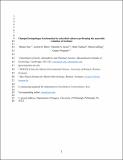| dc.contributor.author | Ono, Shuhei | |
| dc.contributor.author | Rhim, Jeemin H | |
| dc.contributor.author | Gruen, Danielle S | |
| dc.contributor.author | Taubner, Heidi | |
| dc.contributor.author | Kölling, Martin | |
| dc.contributor.author | Wegener, Gunter | |
| dc.date.accessioned | 2022-01-26T15:25:21Z | |
| dc.date.available | 2021-10-27T19:53:49Z | |
| dc.date.available | 2022-01-26T15:25:21Z | |
| dc.date.issued | 2021-01 | |
| dc.date.submitted | 2020-03 | |
| dc.identifier.issn | 0016-7037 | |
| dc.identifier.uri | https://hdl.handle.net/1721.1/133614.2 | |
| dc.description.abstract | © 2020 Elsevier Ltd Methane is abundant in marine subsurface sediments, sourced from microbial or thermocatalytic production. The relative composition of its isotopologues (12CH4, 13CH4, 12CH3D and 13CH3D) is used to infer its sources and sinks. The anaerobic oxidation of methane (AOM) is an important methane sink reaction carried out by consortia of anaerobic methanotrophic archaea (ANME) and partner bacteria in the presence of methane and sulfate. We investigated the methane isotopologue fractionations during AOM in experiments with cultures of ANME-1 archaea and partner bacteria obtained from hydrothermally heated gas-rich sediments of the Guaymas Basin. During partial methane consumption in four sets of experiments, residual methane became enriched in 13CH4 and 12CH3D, following kinetic fractionations from 11.1 to 18.3‰ and from 117 to 180‰, respectively. Results from one set of experiments with D-depleted medium water (δD = –200‰, whereas the control was –55‰) suggest the potential reversibility during the methane activation step, which would contribute to equilibrium as opposed to kinetic fractionations. The value of Δ13CH3D (the abundance of 13CH3D with respect to that expected from stochastic distribution) increased toward and beyond (up to 8.4‰) the value expected for isotopologue equilibrium (5.3‰ at 37 °C). The kinetic clumped isotopologue fractionation (difference between 13CH3D/12CH3D and 13CH4/12CH4 fractionations) of 4.8 to 12.8‰ is in contrast with our previous observation of little to no clumped isotopologue effect during aerobic methane oxidation. Our results demonstrate that AOM can contribute to near-equilibrium Δ13CH3D values observed in marine sediments and 13CH3D systematics can be used to distinguish aerobic versus anaerobic methanotrophic processes in nature. | en_US |
| dc.language.iso | en | |
| dc.publisher | Elsevier BV | en_US |
| dc.relation.isversionof | http://dx.doi.org/10.1016/J.GCA.2020.10.015 | en_US |
| dc.rights | Creative Commons Attribution-NonCommercial-NoDerivs License | en_US |
| dc.rights.uri | http://creativecommons.org/licenses/by-nc-nd/4.0/ | en_US |
| dc.source | chemRxiv | en_US |
| dc.title | Clumped isotopologue fractionation by microbial cultures performing the anaerobic oxidation of methane | en_US |
| dc.type | Article | en_US |
| dc.contributor.department | Massachusetts Institute of Technology. Department of Earth, Atmospheric, and Planetary Sciences | |
| dc.relation.journal | Geochimica et Cosmochimica Acta | en_US |
| dc.eprint.version | Original manuscript | en_US |
| dc.type.uri | http://purl.org/eprint/type/JournalArticle | en_US |
| eprint.status | http://purl.org/eprint/status/NonPeerReviewed | en_US |
| dc.date.updated | 2021-09-20T17:10:10Z | |
| dspace.orderedauthors | Ono, S; Rhim, JH; Gruen, DS; Taubner, H; Kölling, M; Wegener, G | en_US |
| dspace.date.submission | 2021-09-20T17:10:12Z | |
| mit.journal.volume | 293 | en_US |
| mit.license | PUBLISHER_CC | |
| mit.metadata.status | Authority Work Needed | en_US |
